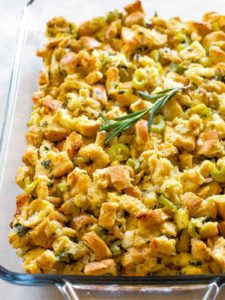OCTOBER 21, 2021
Hello Everyone,
We are close to winding down, but there is still a wealth of wonderful fall veggies coming our way.
Today’s recipe is one for making stuffing with leeks. Since Thanksgiving is approaching, you might want to try it, although stuffing is great anytime.
Leeks are a member of the allium family. They are the mild sisters of onions, garlic, shallots, and chives. Ordinarily, only the white and light green parts are used in making most dishes, but you shouldn’t throw the green parts away.
STUFFING WITH LEEKS
1 small loaf (1 lb) day-old crusty sourdough bread
½ cup salted butter
2 leeks, dark green leaves removed, halved lengthwise, thinly sliced, and rinsed well (2 cups)
4 celery stalks, diced (1¾ cups)
3 garlic cloves, chopped
¾ teaspoon sea sal
½ teaspoon freshly ground black pepper
¼ cup chopped sage
Heaping ¼ cup chopped parsley
1 tsp chopped rosemary
1 tsp fresh thyme leaves
2 cups vegetable broth (chicken broth is okay too).
2 eggs, beaten
1 TBS extra-virgin olive oil
-
Preheat the oven to 350 degrees. Grease a baking dish.
-
Tear the bread into 1-inch pieces and place it in a very large bowl.
-
Melt the butter in a large skillet over medium heat. Add the leeks, celery, garlic, salt, and pepper, and sauté for 5 minutes, turning the heat to low halfway through.
-
Pour the leek mixture over the bread and sprinkle with the sage, parsley, rosemary, and thyme. Use your hands to toss the mixture until the bread is coated. Pour the broth evenly over the stuffing and toss to coat. Add the eggs and toss again. The bread will feel wet. If it’s still a bit dry, mix in an additional ½ cup of broth. The amount you use will depend on how dry the bread is.
-
Transfer the mixture to the baking dish.
-
*If you are making this dish ahead, cover the dish with foil and store it in the refrigerator until you are ready to bake.
-
When you are ready to bake, drizzle the olive oil on top of the stuffing and bake, covered, for 30 minutes. If the stuffing is still pretty wet, uncover the dish and bake for 5 to 10 more minutes to crisp the top a bit.
HELPFUL HINT: Cut the dark green leave off the leeks, put them into an airtight bag, and freeze them. They’re great in soups and stews.
ANOTHER HELPFUL HINT: It is important to tear the bread. Don’t cut it!
Enjoy!
Have a delicious week!
Best,
Judi


